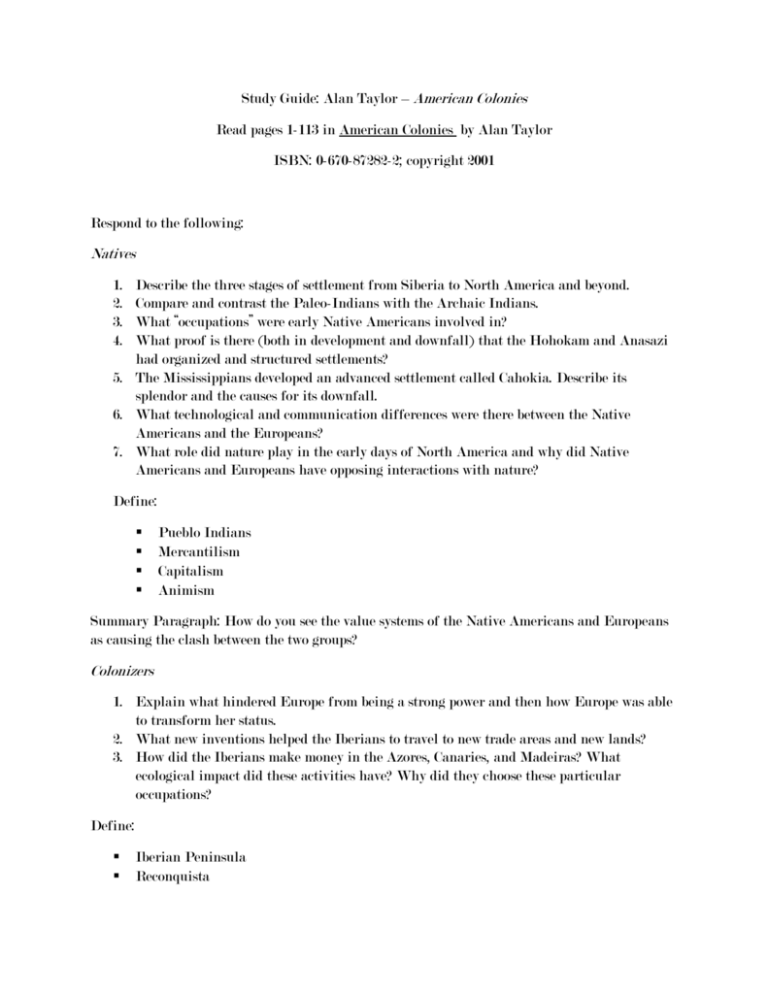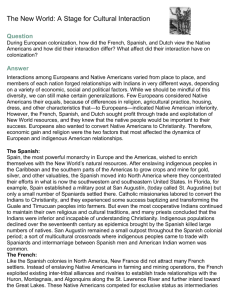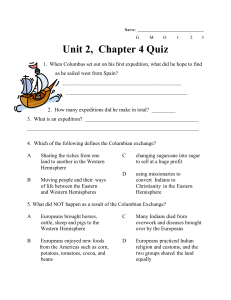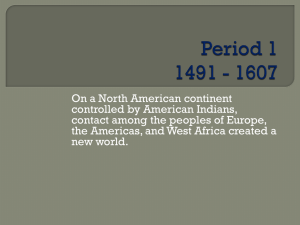Study Guide: Alan Taylor – American Colonies Read pages 1
advertisement

Study Guide: Alan Taylor – American Colonies Read pages 1-113 in American Colonies by Alan Taylor ISBN: 0-670-87282-2; copyright 2001 Respond to the following: Natives 1. 2. 3. 4. Describe the three stages of settlement from Siberia to North America and beyond. Compare and contrast the Paleo-Indians with the Archaic Indians. What “occupations” were early Native Americans involved in? What proof is there (both in development and downfall) that the Hohokam and Anasazi had organized and structured settlements? 5. The Mississippians developed an advanced settlement called Cahokia. Describe its splendor and the causes for its downfall. 6. What technological and communication differences were there between the Native Americans and the Europeans? 7. What role did nature play in the early days of North America and why did Native Americans and Europeans have opposing interactions with nature? Define: Pueblo Indians Mercantilism Capitalism Animism Summary Paragraph: How do you see the value systems of the Native Americans and Europeans as causing the clash between the two groups? Colonizers 1. Explain what hindered Europe from being a strong power and then how Europe was able to transform her status. 2. What new inventions helped the Iberians to travel to new trade areas and new lands? 3. How did the Iberians make money in the Azores, Canaries, and Madeiras? What ecological impact did these activities have? Why did they choose these particular occupations? Define: Iberian Peninsula Reconquista Hidalgos Plantation Columbus 1. Why did the Portuguese travel south and east in their journeys? 2. What were the motivators and influences on Christopher Columbus’ voyages and what experience prior to reaching the New World did he have that prepared him for that trip? 3. What accomplishments did the Norse make in exploration and colonization and how did they fall? 4. How did the calculations of the circumference of the earth impact voyages around the world, including Columbus’? 5. Explain Columbus’ treatment of the Tainos and why he believed it was justifiable. 6. How did King Ferdinand and Queen Isabella react to Columbus upon his return in 1493? 7. How did Columbus treat the Tainos and the Spanish after his first 39 settlers were killed? How many voyages to America did he make? What was his fate in his last years? Explain the accomplishments of the following as well as what country is involved: Bartolomeu Dias 1487 Vasco da Gama 1498 Treaty of Tordesillas 1494 John Cabot 1494 Padro Alvares Cabral 1500 Amerigo Vespucci 1501 Summary paragraph: Using the section entitled Hispaniola (p. 38-39) as an example, as well as the 2 reading sections above, explain whether or not you agree or disagree that the result of Spanish colonization techniques, they advertently or inadvertently led to a genocide of the Native Americans. Epidemics, Food, and Ecological Imperialism 1. What are the probable estimates for the number of Native Americans living in the western hemisphere as the Spanish arrive? 2. What disease were Europeans subjected to? 3. How come more Native Americans died from disease than Europeans and what diseases were they most vulnerable to? Explain in detail each factor for the idea that Europeans were less prone to the same sicknesses as Native Americans and for why Native Americans were literally killed off by these diseases. 4. Why was it so difficult to contain the diseases the Europeans brought with them to America? 5. What were the symptoms and consequences of smallpox? 6. What was the explanation for the diseases and how did these diseases impact the culture of the Native Americans? 7. How did the epidemics upon Native Americans effect the slave trade and the advent of European settlement? 8. What new plants and animals did Europeans introduce to America and how did it effect the populations living here? Refer both to animals and weeds. 9. How did Native American tribes respond both positively and negatively to the new species of plants and animals introduced? Chapter 3: New Spain 1. What can Spain claim about its New World empire? Conquests, Conquistadores, and Consolidation 1. What Spanish practices led them to hear of the Aztecs? 2. How did Hernando Cortes come to conquer the Aztecs in 1519? Explain his own actions as well as how he was able to defeat them, including what happened to Moctezuma. 3. What were the physical differences noticed by the Spanish between their cities and the Aztecs? 4. How did Cortes benefit personally from his conquering of the Aztecs? 5. What did Francisco Pizarro do? 6. What were all the factors gave the Spanish an advantage in fighting and conquering the Native Americans? 7. How did Spanish use the requerimiento to justify killing Native Americans? 8. Describe the different views towards Native Americans of the conquistadors, missionaries, and Spanish monarchs. Define: Encomienderos Bartolome de Las Casas Colonists, Empire, and Gold and Silver 1. 2. 3. 4. Describe the people most likely to leave Spain for the New World. How did Spanish settlement promote diversity in Mexico and the rest of New Spain? How were cities expanded and controlled in New Spain? Explain the viceroyalties as well as their relation with the Spanish monarchy. How would you characterize this type of governing – comment also on how the three types of leaders reacted to their charge. 5. Why was it difficult for the monarchy to enforce its decisions? 6. Explain how gold and silver impacted the Spanish monarchy, laborers, manufacturing, How did it impact Spain’s empire in America? 7. What factors, primarily by other European countries, led to the reduction of Spain’s empire? Chapter 4: The Spanish Frontier Cabeza De Vaca, Soto, and Coronado 1. What happened to Cabeza de Vaca and how did his experiences influence Spanish explorers? 2. Where did Hernando de Soto travel and what Indian tribe did he encounter? How did he treat the Indians and what were they looking for that led to this treatment? 3. What happened to the Mississippians as a result of De Soto’s travels? Explain the transfer of power from the valleys to the hills. 4. What were the new confederacies that came from the Mississippians? How was their lifestyle different from their predecessors? 5. What information led the Spanish to send Francisco Vasquez de Coronado to the Rio Grande/New Mexico area? 6. What did Coronado find at Hawikuh? What did Fray Marcos tell him he would find? 7. Why did Coronado call the people Pueblo? What was the reality regarding unity of the tribes around the Rio Grande? 8. What happened when the Spanish journeyed to Quivira? 9. What was Coronado’s fate? Define: Ethnogenesis Florida and New Mexico 1. 2. 3. 4. 5. 6. 7. 8. Why did the Spanish establish a colony in Florida and who became the leader? Who are the Huguenots and what happened to them in Florida? What is St. Augustine famous for? Explain how the friars became the main connection between the Spanish and Indians, including how they lived together. Describe the circumstances that led to Don Juan de Onate being replaced as adelantado of New Mexico. What was life like in New Mexico during the 17th century? How did the Franciscan missionaries change Indian culture? How did the Pueblos respond to conversion? What good/advantages did the Pueblo see in having a relationship with the Franciscans? The New Mexico Missions and The Pueblo Revolt 1. How did the Franciscan missionaries change Indian culture? How did the Pueblos respond to conversion? 2. What good/advantages did the Pueblo see in having a relationship with the Franciscans? 3. What was the dedication to Christianity on the part of the Pueblos? 4. Describe the conflict between governors and friars in New Mexico. 5. How did both the drought and the reaction of the governors to Pueblo traditions stimulate the revolt? 6. How did Pope get support from the Pueblo people to revolt in 1680?What impact did the rebellion have? 7. What happened after the rebellion and as a result of Governor Diego de Varga? What changes were made in Spanish control over the Pueblos? 8. Explain the alliance between the Hispanics and Pueblos after the revolt. Canada and Iroquoia 1. Why di the French settle in the north of North America? What happened to their settlement led by Jacques Cartier? 2. What resources did the French find profitable in the Gulf of St. Lawrence? 3. How did the fur trade lead to mutuality of dependence between the Indians and French settlers? 4. Where did the Iroquois and Algonquian tribes live geographically? What were their lifestyles in regards to economy? 5. Who were the French allies? Define: Northwest Passage The Fur Trade 1. Who controlled fishing around Newfoundland? 2. What happened to Sir Humphrey Gilbert in 1583? 3. What role did the Indians play in the fur trade? Describe the result of the commercial interactions between Europeans and Indians including shiny objects, alcohol, trading policies, demands for Europeans products, the environment, competition. Define: wampum Canada 1. Why did the French abandon their original settlements and what were the five reasons they chose the St. Lawrence Valley? 2. Who founded Quebec in 1608 and how successful was the colony? 3. Why are the Huron good allies to the French? How did they obtain the furs? 4. What were the tribes that made up the Five Nation Iroquois and who were their enemies (both Indian and European)? 5. Why did the French treat Indians well? 6. Describe what happened to Champlain in June 1609. How did this change warfare in Canada? The Five Nations 1. How come the Five Nation Iroquois became a great war power? 2. How did the Iroquois handle grief when a man died in battle and what happened to POWs chosen for death and adoption? 3. What was comparable in Europe to the way enemies were treated? 4. What did Deganawida and Hiawatha do? 5. How was the Iroquois Great League tied together and what was its internal impact? 6. How did the Iroquois refocus warfare? What tribe did they engage in battle with? 7. What caused death to the Iroquois in the early 17th century? The Dutch Trade 1. Who was Henry Hudson and what did the Dutch do in 1614? 2. What could the Dutch provide for the Iroquois? 3. Once the Dutch came, how did this impact French relations with the Iroquois? Jesuits and Destruction 1. How did French missionaries promote the Counter-Reformation? 2. How did Europeans view non-Europeans? 3. What did the Indians call the Jesuits and how come the Huron were fairly easy to convert? 4. How did Jesuits go about converting the Hurons?






